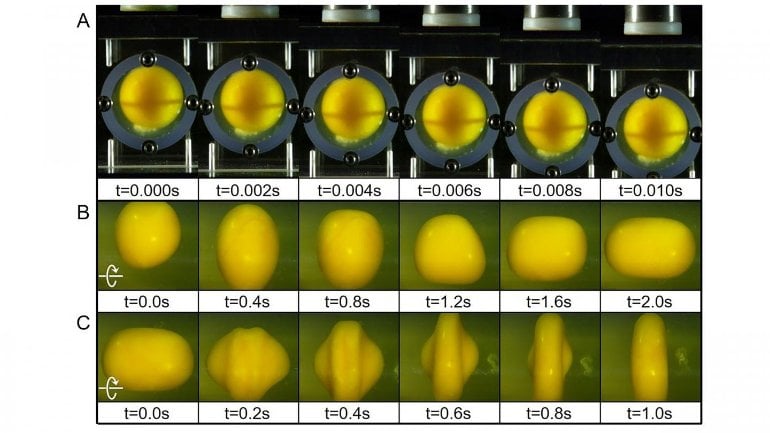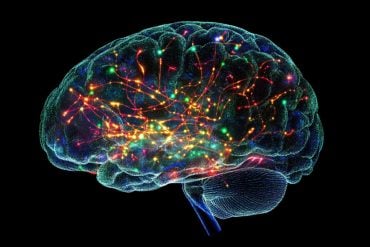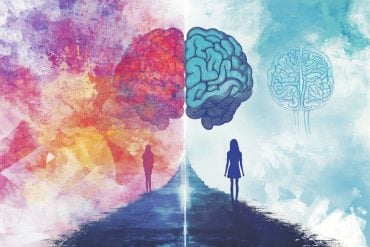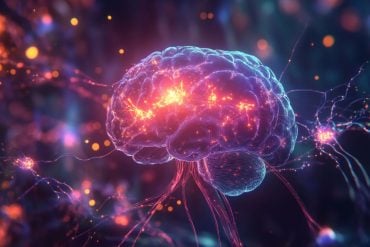Summary: Using an egg, researchers discover how trauma occurs to the brain as a result of impact.
Source: American Institute of Physics
What causes brain concussions? Is it direct translational or rotational impact? This is one of the research areas currently being explored by Qianhong Wu’s lab at Villanova University.
Our brains consist of soft matter bathed in watery cerebrospinal fluid (CSF) inside a hard skull. An impact on the hard skull is transmitted through the thin layer of CSF within the subarachnoid space to the soft brain matter.
In Physics of Fluids, from AIP Publishing, Wu and co-authors Ji Lang and Rungun Nathan describe studying another system with the same features, an egg, to search for answers. An egg resembles the brain, because its soft yolk is bathed within a liquid egg white inside a hard shell.
Considering that in most concussive brain injuries, the skull does not break, Wu wanted to find out if it was possible to break or deform the egg yolk without breaking the eggshell.
The researchers did a simple experiment using an egg scrambler, from which they could see that rotational force can easily break the egg yolk and make it mix with the egg white.
In terms of basic concepts behind this work, a soft capsule — membranebound soft matter — is bathed within a contained liquid. The capsule has an impermeable membrane, separating the liquid inside the capsule from the outside.
Two types of impacts can be imposed on the outer container. A translational impact is one that hits the container directly, while a rotational impact occurs when the outer container is accelerated or decelerated rotating. The latter arises naturally in sports when helmets are not round. Consider, for instance, the pair of stiffening ridges behind many ice hockey helmet designs.
The researchers discovered something quite counterintuitive and very surprising. Direct translational impact does not cause the egg deformation, while rotational deceleration causes tremendous egg yolk deformation. This finding sheds light on the motion and deformation of our brain when the head is exposed to sudden external impacts.
“We suspect that rotational, especially decelerational rotational, impact is more harmful to brain matter,” said Wu. “The large deformation of brain matter during this process induces the stretch of neurons and causes the damage.”
This finding explains why boxers will very likely faint if hit on the chin.

“Considering the chin is the farthest point from the neck, hitting on the chin could cause the highest rotational acceleration/deceleration of the head,” he said.
When it comes to concussions, which are a serious issue for public health, “it remains unclear how the brain is injured and how to avoid such injuries,” said Wu.
“Critical thinking, along with simple experiments within the kitchen, led to a series of systematic studies to examine the mechanisms that cause egg yolk deformation,” Wu said. “We hope to apply the lessons learned from it to the study of brain biomechanics as well as other physical processes that involve soft capsules in a liquid environment, such as red blood cells.”
As the first study of its kind, this work provides a new perspective for understanding the response of a membranebound soft object to sudden external impacts. This new perspective will interest those designing helmets.
About this neurology research news
Source: American Institute of Physics
Contact: Larry Frum – American Institute of Physics
Image: The image is credited to Ji Lang and Qianhong Wu
Original Research: Closed access.
“How to deform an egg yolk? On the study of soft matter deformation in a liquid environment” by Qianhong Wu, Ji Lang, and Rungun Nathan. Physics of Fluids
Abstract
How to deform an egg yolk? On the study of soft matter deformation in a liquid environment
In this paper, we report a novel experimental study to examine the response of a soft capsule bathed in a liquid environment to sudden external impacts. Taking an egg yolk as an example, we found that the soft matter is not sensitive to translational impacts but is very sensitive to rotational, especially decelerating-rotational, impacts, during which the centrifugal force and the shape of the membrane together play a critical role in causing the deformation of the soft object. This finding, as the first study of its kind, reveals the fundamental physics behind the motion and deformation of a membrane-bound soft object, e.g., egg yolk, cells, and soft brain matter, in response to external impacts.






